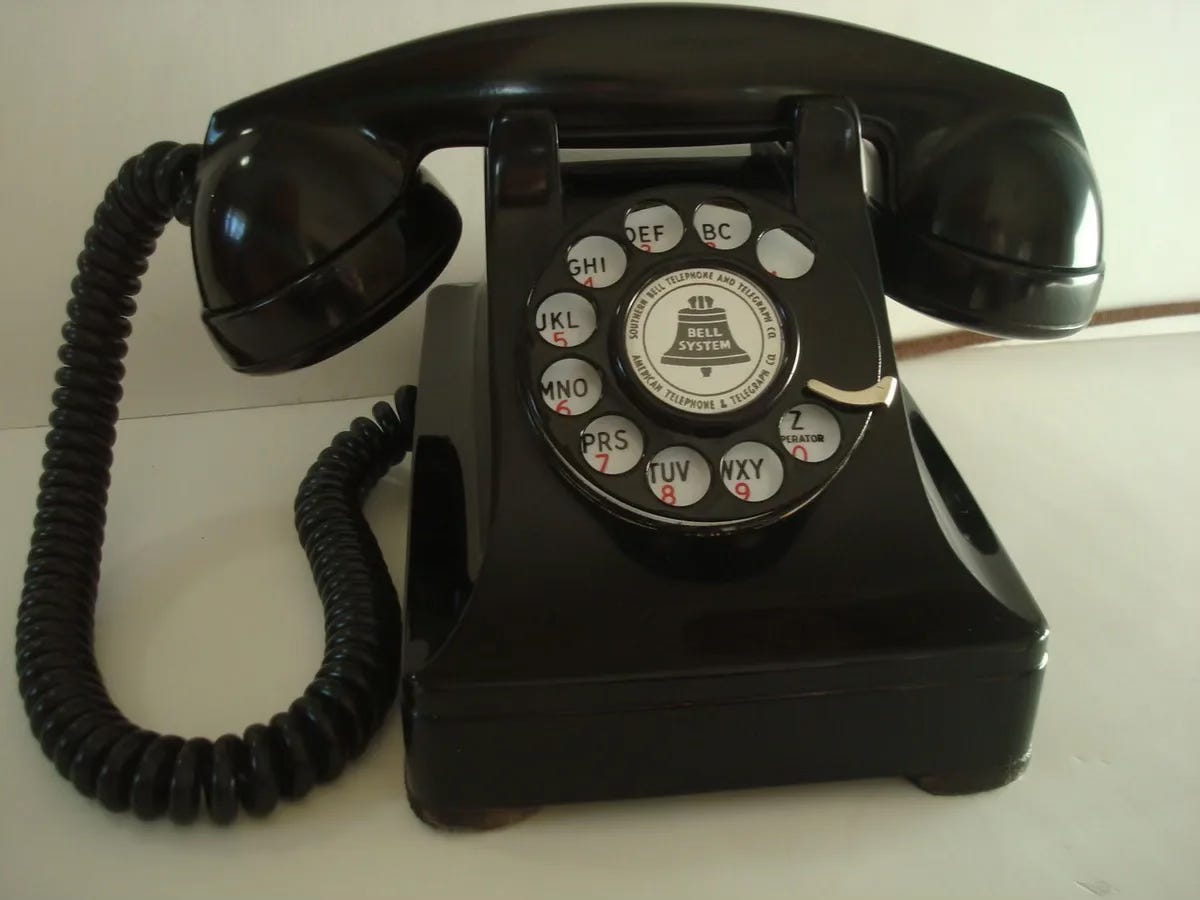[originally published 2 December 2024]
First things first, a Note on Notes.
I’ve been informed that not all my readers are aware that these essays’ myriad footnotes are in fact linked to the text, which not-awareness has led to people’s either scrolling violently back and forth (i.e., up and down), which I’d think must be dizzying, or, ingeniously and heroically, reading on two screens simultaneously.
It doesn’t have to be that hard!
If you’re reading on a desktop computer and you hover your cursor over the superscript numbers in the text, the footnotes should pop right up. If they don’t, and particularly if you’re receiving these Substack essays via email, you can, once you’ve opened the email, click on the headline, which will open the essay in a new browser window with, I’m advised, guaranteed workable footnotes.1
And if you’re reading on your phone—well, I can speak only for my iPhone, but I trust it’s the same deal for all phones more advanced than this:
—you can simply boop the superscript number as if it were a dog’s nose, and voilà! (And then you just X the note away when you’re done reading it.)
And now, today’s ’stack.
A long, long time ago, someone said to me, or perhaps I read it:
“If you’ve ever thought you’re the only person in the world to have thought something, welcome to the internet.”
For instance, I’m always happy to tell on myself that for a perhaps embarrassingly long time, every time I saw the word “stucco” I thought it meant this:
Why? Because every time I saw a picture of an edifice described as stucco, the edifice was topped with pretty curled red roof tiles, and it would never have occurred to me that anyone would waste a jaunty-looking word like “stucco” on something as dreary-looking as this stuff:
Eventually, I’m happy to report, I figured it all out, but I was beyond delighted, not so very long ago today, to learn that I was not in fact the only person in the world to have ever entertained this misapprehension, and I took and take great comfort in this.
Persistent delusions about the meanings of words can certainly arise from childhood inferences, as above, that are never again, as they say these days, interrogated, those inferences often exacerbated by possessing the little bits of knowledge that are, famously, dangerous things, and all of this no doubt compounded by a streak of laziness about cracking open the dictionary.
However they occur, I think that these wordy mixups can be both fun and funny, and in between always wanting to get everything precisely right, I can take some time out to enjoy wandering my own and others’ odd paths to crackpot certainty.
To be sure, not all of these mixups are quite so, as my stucco one was, lunatic. Many people, for instance, not entirely unsensibly think that the word “pulchritude” means buxomness, no doubt because the word is often applied to amply curvy female persons. And yet the word simply means, without any mandatory zaftigness (or should that be zaftigicity?)2 built into it, beauty and comeliness (though it is, I’d say, a notably unbeautiful and uncomely word). Also, as a dear friend reminds me, we already have a particularly toothsome, evocative word for extravagant and often appealing curviness, and that word is “embonpoint,”3 which if you’re so inclined can be subdivided into ventral and dorsal embonpoint.4
Also in this vein, as I and others have often had cause to point out, “coruscating,” a bracingly attractive word for sparklingness, is in the unhappy process, perhaps because it seems to be almost invariably joined to the word “wit,” of being redefined to mean something like “direly and viciously critical”—in part because what is wit if it isn’t wielded to insult and to put down? (sigh), and also, certainly, because the word literally looks as if it means corrosive and scathing, with a side order of excoriating.5
Truly bonkers pleasure, I’ve learned, can be derived from attending people’s thoughts on the subject of colors, where, truly, anything goes.
I’ll be the first to admit that for some absolutely unknown reason I’ve decided that “cyan” is a shade of red, and you can tell me from now till the cows come home that it’s a shade of greenish-blue, but I’m probably not going to believe you.6
And speaking of the green family, not a few smarty-pantses, I have just now learned, want “vermilion” to be a kind of green because they get as far as “ver” and see “vert” and “verdant.” It is, of course (I add “of course” because for once in this discussion I’m smugly sure of knowing something), a version of red that cyan most certainly isn’t, and it derives (literally, it used to be made of it) from cinnabar, which is, if you ask me, a much more intuitive word. For further information, do, I urge you, google “vermilion etymology” and you’ll learn a lot.7
The champion in this category might well be puce, which our friends at Merriam-Webster advise us is “a dark red or purple-brown color,” and which today I have learned is taken variously to be (you don’t have to believe me, but I have the receipts) a “Goth dusty rose,” a version of taupe, a version of beige, a “sickly greenish yellow,” and a “horrible yellow-green-brown.”8
All this said, I’ll take my leave today by offering you something that may either comfort you or infuriate you, my favorite word that correctly means so many things that it seems as if it could mean anything or everything. I give you:
livid
Have a lovely rest of the day.
Benjamin
Thank you for being here, and thank you especially for subscribing, if you’ve done that, and I thank you especially especially for being a paid subscriber, if you’ve been moved to become one.9 Though I note, as always, that my Substack content is free to all readers and will remain that way.
Alternatively, if you’re moved to support me and my work somehow and would like to have something solid in your hands to show for it, do consider, especially with the holidays coming up, what I tend to refer to as The Book, to say nothing of The Game, the latter of which especially, IISSM, makes a great stocking stuffer.
Huge gratitude to Steven D. Greydanus for patiently explaining this to me.
Speaking of zaftigness (or, indeed, zaftigicity), in the spirit of tidiness I urge you to apply the word “hippy” to people who are a bit thick around the lower middle and “hippie” to love-bead wearers with some flowers in their hair (even though, yes, “hippy” is an accepted variation of “hippie”). As I will also reserve “lefty” for people who are left-handed and “leftie” for, as Stephen Sondheim memorably phrased it, “pinko commie tool[s].” YM, as they say, MV.
“There was another light in the room now, a thousand times brighter than the night-lights, and in the time we have taken to say this, it had been in all the drawers in the nursery, looking for Peter’s shadow, rummaged the wardrobe and turned every pocket inside out. It was not really a light; it made this light by flashing about so quickly, but when it came to rest for a second you saw it was a fairy, no longer than your hand, but still growing. It was a girl called Tinker Bell exquisitely gowned in a skeleton leaf, cut low and square, through which her figure could be seen to the best advantage. She was slightly inclined to embonpoint.”
—J. M. Barrie, Peter and Wendy

Speaking of dorsal embonpoint, consider another peculiar-looking word: “callipygian,” which means “having shapely buttocks,” and which, because I suppose I first encountered it in accounts of the horribly exploited so-called Hottentot Venus, Sarah Baartman, I’ve always reacted badly to. Plus the whole it’s-not-a-very-nice-looking-word-is-it thing. Also the whole do-we-really-need-a-word-for-this thing.
The two, I’d say, most notable words currently in the process of being miserably redefined are “bemused” and “nonplussed,” but I’d be perfectly happy this lovely day not to inspire the endless geschreiing that attaches to discussions of either. Another, gloomier day, perhaps.
If I were medically inclined, familiarity with the word “cyanosis” might have pushed me in the right direction, but alas I’m not medically inclined. Perhaps I’m mixing up “cyan” with “cerise”? Who knows.
You’ll also probably be grossed out.
For you Auntie Mame fanatics I’m happy to pose the immortal question “And what’s wrong with Muriel Puce?” For the rest of you, speaking of being grossed out, have fun googling “puce etymology,” and don’t say I didn’t warn you.









A caveat on Notes: If you are reading the email newsletter version, the happy linking/pop-up functionality described above may not work! This is partly why I encourage readers accessing Substack content via email to click the headline to open in a browser. (Another reason is that any post-publication updates will not be represented in the email version.)
If I read your pieces in e-mail, the footnotes don’t work. If I read them in the app, they work.
I still advise reading straight through on a first pass, and then a second time to savor the footnotes and what they reveal, or don’t, about the way your mind works.